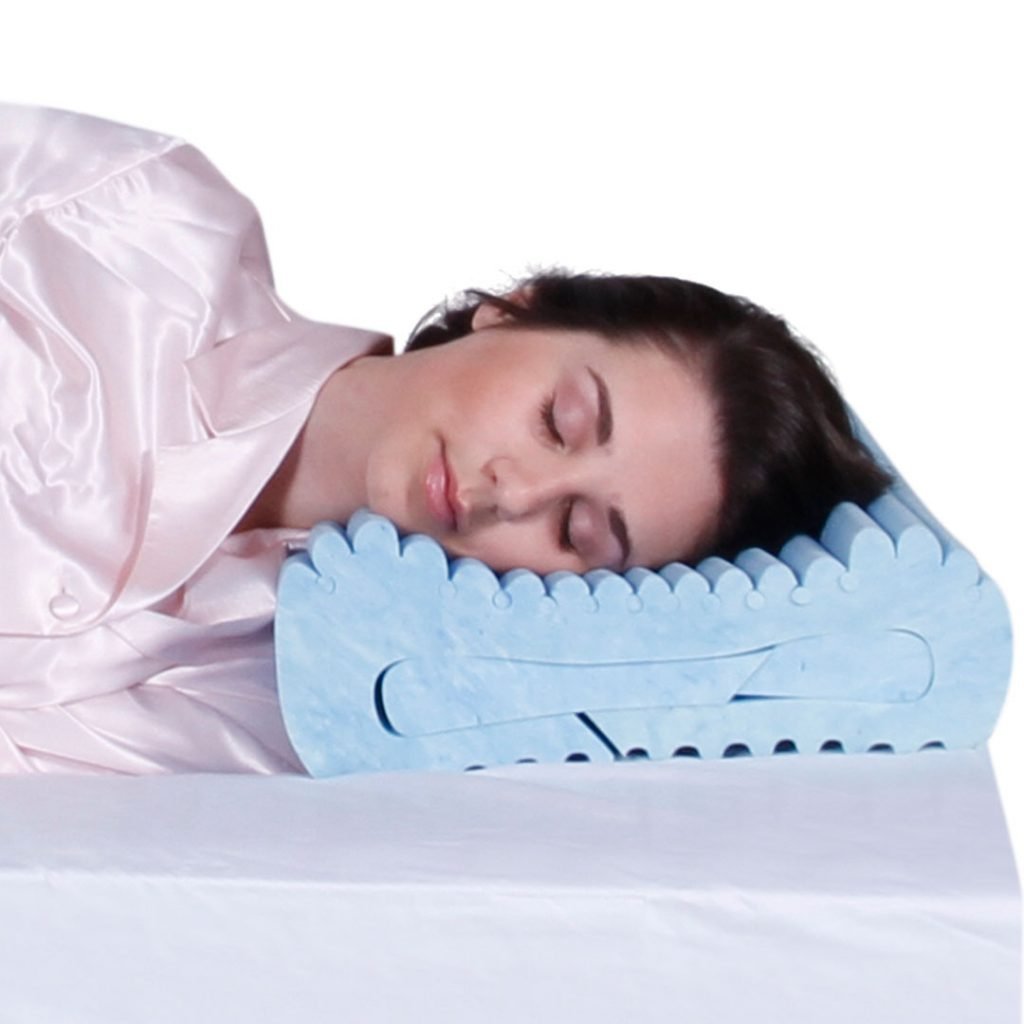Selecting the right pillow is a critical aspect of ensuring a sound sleep experience and overall health improvement.
With a myriad of options available in the market, choosing a pillow can be an overwhelming task. One of the key factors to consider when making your choice is the type of material that makes up your pillow.
From memory foam and polyester to feathers, each material has its unique attributes that cater to diverse needs and preferences. In this comprehensive guide, we delve into the specifics of these pillow materials and also introduce four additional types - gel-infused pillows, wool-fill pillows, and latex - to provide you with an all-encompassing understanding and help you make an informed decision.
Memory Foam Pillows
Memory foam, a type of dense and viscous polyurethane, has gained substantial popularity as a pillow material. Enhanced with chemicals to increase its density, memory foam reacts to heat and pressure, contouring your body shape for personalized comfort. Once the pressure and heat are removed, it reverts to its original form. Memory foam pillows are particularly favoured for their excellent comfort and support for those with neck and back problems.
However, it's important to be aware of some drawbacks. Memory foam pillows can sometimes emit a chemical smell and retain body heat, potentially leading to discomfort in warmer climates. It's also noteworthy that memory foam is not recommended for infants due to potential difficulties with rolling over.
Polyester Pillows
As one of the most common and inexpensive materials, polyester is widely used for pillow manufacturing. Polyester pillows are durable, washable, and suitable for a range of purposes from sleep to decor. Despite these benefits, polyester pillows can sometimes emit odours and are more susceptible to dust mites due to poor ventilation. They also often provide subpar neck support and tend to become compressed over time, requiring replacement every couple of years.
Feather Pillows
Long hailed for their supreme softness, feather or feather-and-down combination pillows have been a favourite for many. These pillows are durable, flexible, lightweight, and incredibly plush. However, they come with their own set of challenges. Feather pillows can be noisy, and the feathers can poke through the pillow, requiring regular shaking and fluffing. Moreover, the plastic layer commonly added to contain the quills may generate noise and lose its effectiveness as the pillow ages.

Gel-Infused Pillows
Gel-infused pillows represent a significant step forward in pillow technology. They incorporate tiny gel beads into memory foam, improving its breathability and cooling capabilities. The gel infusion helps distribute heat away from the body, ensuring a cooler and more comfortable sleep experience - a boon for those in warmer climates or who naturally sleep hot. These pillows also retain the traditional memory foam advantages of pressure relief and support.
Wool Fill Pillows
Wool-filled pillows provide a natural and eco-friendly pillow option. Wool has excellent temperature regulation properties, keeping you warm in the winter and cool in the summer. It also resists dust mites and mould, making it a great option for allergy sufferers. Moreover, wool-fill pillows offer a firm and supportive sleep surface. However, they may not be as soft or malleable as other types, which might not appeal to everyone.
Latex Pillows
Latex pillows, particularly those made from natural latex, offer a balance of softness and support that can aid in relieving neck, shoulder, and back pain. They are also resistant to dust mites and mould, and they're known for their durability. On the flip side, latex pillows can be relatively heavy and may have a slightly rubbery scent. They also tend to be more expensive than other types.
Your pillow can greatly influence the quality of your sleep and, in turn, your overall well-being. It's essential to consider not only the immediate comfort a pillow offers but also how its material and construction may support your neck and spine alignment, manage heat and moisture, and resist allergens.
When choosing your pillow, consider your sleeping style. Side sleepers typically need a firmer, higher loft pillow to support their neck and shoulder. Back sleepers generally require a medium to firm pillow, while stomach sleepers usually find a softer, lower loft pillow more comfortable.
Investing time in understanding the various pillow materials and their characteristics can guide you to find the perfect pillow that aligns with your individual needs and preferences.
Gel-infused pillows offer the benefits of memory foam with added cooling properties. Wool-filled pillows are natural, hypoallergenic, and temperature-regulating, though they might lack the softness some prefer.
Latex pillows offer an excellent balance of softness and support, resistance to allergens, and durability, but they might be on the heavier side and a bit pricey.
Consider also that you may benefit from a combination of materials, such as a latex pillow for head support and memory foam or a gel-infused pillow for additional comfort and cooling.
The perfect pillow is an investment in your sleep health. Do not rush the process, take your time to consider all the options, and remember, while recommendations and reviews are helpful, the best pillow for you is ultimately the one that feels the most comfortable and supports a good night's sleep.
At pillows.com.au, we offer a wide range of pillow types and materials to cater to every individual's unique sleep needs. Browse our selection to find the perfect pillow for your best night's sleep.
Do you want to learn more? Read our Frequently Asked Questions for...
In modern society, some people are a lot more sensitive to a whole host of different products and airborne nasties.
With regards to polyurethane foam, history can only prove it is certainly not a risk.
In Australia alone thousands of tonnes of foam are produced and sold into areas such as bedding, furniture, automotive, yes products we are exposed to daily.
Hospitals for instance will not accept Latex foam as it is rubber-based, and all hospital mattresses are made from polyurethane foam.
 0
0 0
0No, down pillows are not necessarily bad for asthma. While some people with asthma may be sensitive to certain allergens, such as dust mites, which can be found in down feathers, it does not mean that all individuals with asthma will have a negative reaction to down pillows.
It is important to note that down pillows can be hypoallergenic, meaning they are designed to minimize the risk of triggering allergies or asthma symptoms. These pillows are often made with special materials or treated to reduce allergens. However, it is always recommended to check the product description or label to ensure that the down pillow you choose is hypoallergenic if you have asthma or allergies. Additionally, regularly washing and maintaining your pillow can help minimize allergens and keep it clean for a healthier sleep environment.
 0
0 0
0Duck feather pillows are not inherently cruel, but the ethical concerns lie in the sourcing and production processes. Feathers used in pillows can come from ducks that are raised for meat or from live-plucked ducks. Live-plucking involves removing feathers from ducks while they are still alive, which is considered inhumane and cruel. However, many reputable manufacturers now follow strict guidelines and source feathers from ducks that are raised for meat, ensuring that the feathers are a byproduct of the food industry and not obtained through live-plucking. To ensure you are purchasing ethically sourced feather pillows, look for certifications such as the Responsible Down Standard (RDS), which guarantees that the feathers used in the pillows are responsibly sourced and obtained without causing harm to the ducks.
It is important to be aware of the sourcing and production methods when considering feather pillows. By choosing pillows that are certified by organizations like RDS, you can support ethical practices and ensure that the feathers used are obtained without causing harm to ducks. This way, you can enjoy the comfort and support of feather pillows while also promoting animal welfare.
 2
2 0
0Yes, latex pillows can be beneficial for neck pain. Latex is a natural material derived from rubber trees, known for its supportive and contouring properties. These pillows are designed to provide proper alignment and support to the neck and head, which can help alleviate neck pain. Latex pillows offer a unique combination of softness and firmness, allowing them to conform to the shape of your neck while still providing adequate support. The natural elasticity of latex also helps to maintain the pillow's shape and prevent it from flattening over time. Additionally, latex pillows are hypoallergenic and resistant to dust mites, making them a suitable choice for individuals with allergies or asthma. Overall, latex pillows can offer a comfortable and supportive solution for those seeking relief from neck pain.
 0
0 0
0Latex pillows are indeed a good choice for many people. Made from natural latex derived from rubber trees, these pillows offer several benefits. Firstly, latex pillows provide excellent support and comfort for your head and neck. The natural elasticity of latex allows the pillow to conform to the shape of your head, providing optimal alignment and reducing pressure points. This can help alleviate neck and shoulder pain, promoting more restful sleep. Additionally, latex pillows are hypoallergenic and resistant to dust mites, mould, and mildew. This makes them a great option for those with allergies or asthma, as they can help minimize potential triggers. Overall, latex pillows offer a durable and supportive sleep surface, ensuring a comfortable and healthy night's rest.
 0
0 0
0








